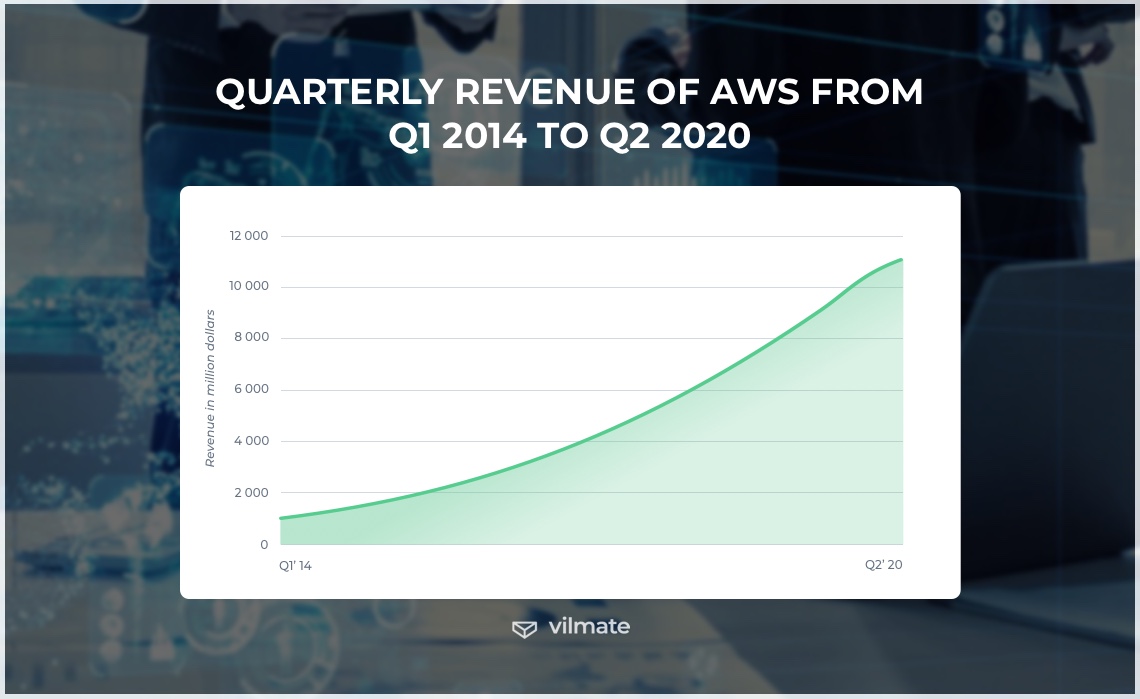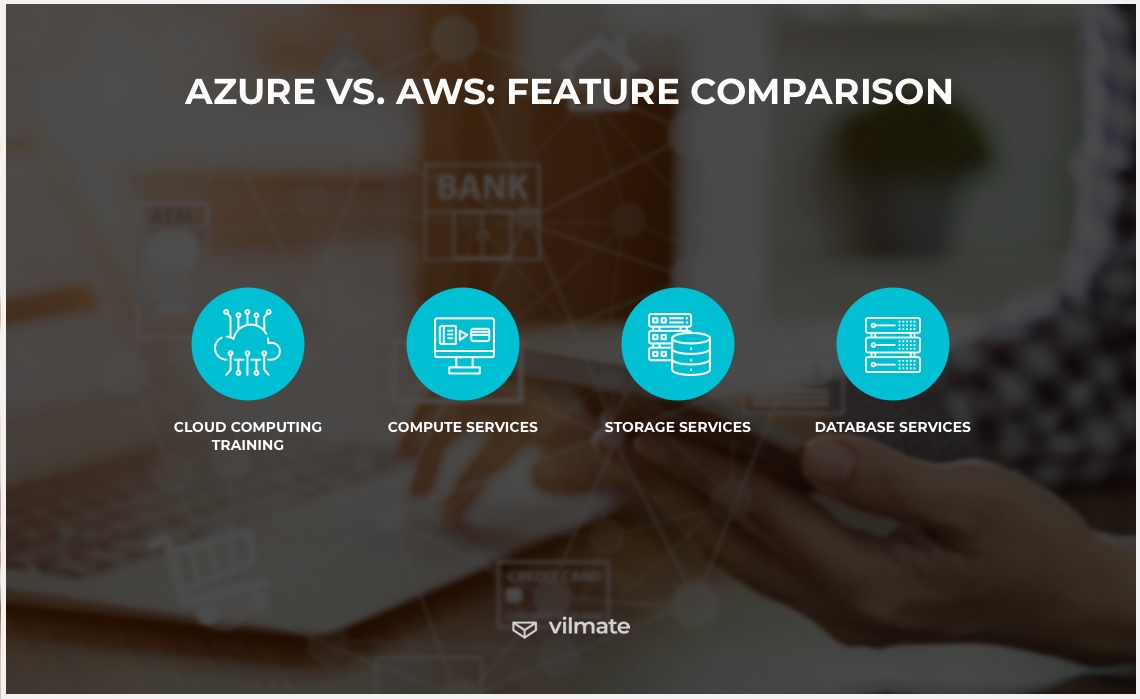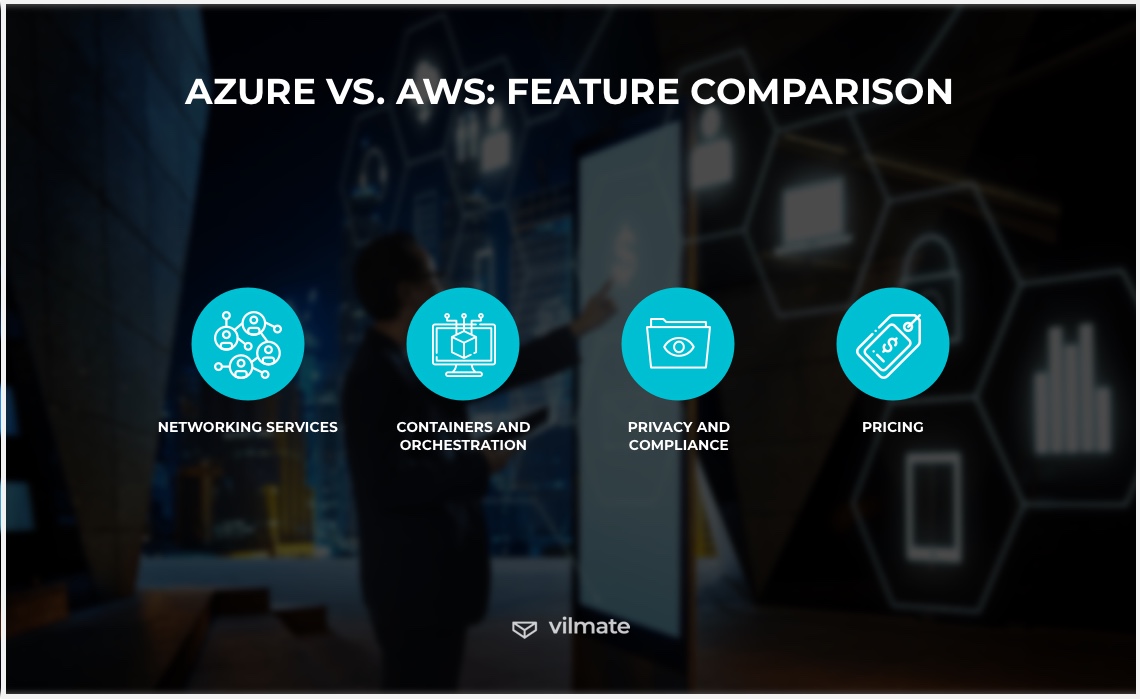Amazon Web Services (AWS) and Microsoft Azure are two popular public cloud services that offer efficient alternatives to traditional on-premise hosting environments. In case you are new to the subject of cloud computing but, at the same time, keep your options open and want to select a cloud platform for your business or choose a cloud service provider to proceed with your career in cloud computing, we are here to help you find your way around the AWS vs. Azure juxtaposition. In this article, we’re going to discuss what AWS and Azure are, their current market share, and how different they are in terms of their features.
What is Amazon Web Services?
Amazon Web Services, or more commonly referred to as AWS, is a multi-billion infrastructure as a service (IaaS) and an on-demand cloud computing platform provided by Amazon. The history of Amazon Web Services goes back as far as 2006. Then it included only three components: Amazon Simple Storage Service (S3), Simple Queue Service (SQS), and Elastic Compute Cloud (EC2). The idea behind AWS was that it would become a platform that could give anyone the uniform technical infrastructure, all the tools needed to start a new company.
AWS is a public cloud in the sense that this cloud infrastructure is designed for open use by the general public. So, what is AWS infrastructure, and what are services provided by AWS then? The shortest answer is that Amazon’s IaaS supports fundamental computing resources, including processing, storage, networks, etc. This, in turn, gives the idea what Amazon Web Services are used for, which is to provide consumers with the necessary means and tools for seamless deployment and running of software like OSs and apps. AWS gives users control over the software they choose to deploy there without bothering them with the underlying cloud infrastructure management and support.
Although the company was not the first to introduce a modern cloud infrastructure to the market, they did it well and eventually succeeded. Since the platform launch, it has been continually evolving, and the number of offered services has been growing.
What is Microsoft Azure?
Microsoft Azure, or shortly Azure, is, by most accounts, a rebirth that Microsoft found through cloud computing. To sound less metaphoric, let’s define what exactly is Microsoft Azure. Azure is a public cloud computing platform available to customers in four different forms: IaaS, PaaS, SaaS, and serverless. The platform’s aim is to help businesses meet their organizational goals. Azure provides customers with a computing environment for developing and scaling new applications or running existing apps in the public cloud. Similar to AWS, Azure cloud environment comes with a range of cloud services, including computing, analytics, storage, and networking.
Microsoft started working on its cloud-computing platform in 2006, just when Amazon Web Services were launched. By working iteratively, the team had gone through a cycle where they performed evaluations each iteration and determined what changes were needed, which resulted in the commercial product launch in 2010. Having entered the business of renting computing power for establishing technology infrastructure over the internet, the Azure development team kept maintaining a focus on ease of use and continued perfecting their offering. In 2014, a significant strategic change was made: Windows Azure was renamed Microsoft Azure. This served as a reminder that Azure could run more than Windows.
As for now, Microsoft Azure is one of several major public cloud service providers. It operates on a global scale and, just like AWS, keeps improving and scaling up. Apart from the private cloud computing services, it has an on-premises version of its public cloud called Azure Stack and a full-fledged private cloud offering called the Azure VMware Solution that delivers VMware-based private clouds. In all the instances, it is Microsoft that is responsible for host maintenance and lifecycle management.
AWS vs. Azure market share
Amazon Web Services and Microsoft Azure are both big players in cloud computing. To better understand who is the largest cloud service provider, let’s compare AWS vs. Azure in terms of their market share.

In Q2 2020, Amazon reported AWS revenue of $10.8 billion, which is a 29% increase comparing to the record of Q2 2019. This made up 12.1% of Amazon’s total revenue for the second quarter and, most significantly, constituted 64% of the company’s profit.
Unfortunately for our cloud comparison, Microsoft does not disclose Arure’s revenue. However, it is reported that the growth rate for Q4 2020 equals 47% over the Q3 2020. Besides, the figures have been falling over the past quarters steadily. Thus, for instance, the revenue growth in Q1 2018 was 90%. The other concrete numbers that are publicly shared testify the “Intelligent Cloud” business that, among others, encompasses Azure produced $13.4 billion in revenue in Q4 2020.
So, which is more popular AWS or Azure? The lack of data makes it more difficult to compare the two providers. However, the most recent report by Synergy Research Group claims that Amazon actually leads the cloud market as its share amounted to 33% in Q2 2020, while Microsoft’s share was only 18%.
One way or another, the fact that AWS has established itself as an early leader on the market for cloud infrastructure that, up to this day, continues to increase revenue at an enormous scale is irrefutable. Besides, it suggests Amazon is truly the number-one provider that dominates the market for now.
Azure vs. AWS: Feature comparison
Despite a quite understandable difference between AWS and Azure in terms of their market share, they are still comparable. If you wonder which cloud platform is best – Windows Azure or Amazon Web Services – what the advantages of AWS are, and if Microsoft Azure is better than AWS, then our cloud marketplace comparison must be just what you need. To say for sure which is better AWS or Azure, we’ve highlighted the most in-demand features of the said cloud providers and analyzed them according to these criteria. Let’s see what we’ve got.

1. Cloud computing training
AWS: Is Azure easier than AWS, or else Azure certification is more difficult to obtain? To successfully move to the cloud, organizations must have trained professionals, certified in cloud computing, on board. These specialists will have to be able to efficiently address the entanglements of transitioning to the cloud. And we must admit both Azure and AWS can be challenging to understand if approached at random. Other than that, however, AWS is claimed to be much easier to master and get certified in. It offers SDKs for quite a number of programming languages and continuously introduces updates following the latest industry trends. Besides, learning AWS seems more accessible due to the broader network of e-learning materials and the availability of the free AWS version that is intended to be used for polishing one’s cloud skills. Last but not least, AWS certification permits access to the global community of AWS certified professionals, including the AWS Certified LinkedIn Community.
Azure: When analyzing Windows Azure vs. AWS cloud computing training and certification programs, we cannot ignore the fact that Azure is the product of Microsoft. As a result, it can be more easily introduced into your business if you’ve already invested in other Microsoft products. Besides, it’s not so long ago that Azure only supported applications based on C++ and C#. In 2019, things started to change, and now there are SDKs for Java, Python, and JavaScript, though many claim C languages have remained the primary ones enjoying somewhat better support. On the other hand, hiring companies still may have tough time sourcing professionals familiar with the nuances of cloud-based computing services provided by Microsoft Azure. This means the demand for talent is not dwindling and, therefore, the offering of training and certification programs will improve as well.
2. Compute services
AWS: Amazon Web Services uses Elastic Compute Cloud (EC2), one of the most mature services on its services offering list, as its key solution for scalable computing. EC2 enables deployment, management, and maintenance of virtual servers that provide secure and reliable compute capacity in the cloud. Since 2006 when EC2 was released, Amazon has presented several important updates and new products, including Amazon EC2 Auto Scaling, Elastic Container Service, Elastic Kubernetes Service (EKS), Elastic Container Registry, Amazon Lightsail, AWS Batch, Outposts, Wavelength, Fargate, Lambda, and more, all of which are focused on providing the optimal quantity and type of compute resources for running software in the AWS cloud computing environment.
Azure: For computing purposes, Azure uses Virtual Machines, an on-demand computing resource that allows rapidly configure and provision instances. This Azure service means the same for Microsoft Azure as EC2 means for AWS. The other Azure-enabled equivalents of AWS services are Virtual Machine Scale Sets, Container Instances, Azure Kubernetes Service (AKS), Container Registry, Azure Batch, Azure Functions, to name a few. All these services make up a convenient infrastructure for deploying, hosting, running and managing the application in the cloud.
3. AWS vs Azure storage services
AWS: Storage services are impossible not to mention when drawing an AWS vs Azure security comparison. They provide secure cloud storage for structured or unstructured data and allow scaling globally while maintaining data privacy and security. The first AWS product called Amazon Simple Storage Service (S3) does this exact job. It is an object storage service that empowers users to organize and manage their data and configure access controls. Other AWS services that help control storage in the cloud include Elastic Block Store (EBS), Elastic File System (EFS), Amazon S3 Glacier, AWS Storage Gateway, Amazon FSx, AWS Snowball, and AWS Backup.
Azure: Microsoft Azure has its own group of services responsible for providing scalable cloud persistent and archival storage. These services protect customers’ data infrastructures while focusing on building valuable software and can even support big data projects. Microsoft Azure provides different storage solutions that support the storage of unstructured data (files, unstructured text, images, health records, etc.), semi-structured data (XML, CSV, JSON, etc. files that do not reside in a relational database), and structured data (SQL relational databases). To use Azure Storage, a customer must create an account and choose a storage service that will satisfy most of the business requirements. The available storage accounts options are General-purpose v1, General-purpose v2, BlockBlobStorage, Azure File Storage, and Azure BlobStorage.
4. Database services
AWS: AWS vs Azure database services are also comparable. Thus, Amazon Relational Database Service (RDS) supports six popular database engines: MariaDB, Amazon Aurora, MySQL, Microsoft SQL, PostgreSQL, and Oracle. RDS makes it easy to set up, operate, and scale a relational database in the cloud, and at the same time, it lets deploy managed databases in on-premises VMware environments. Besides, AWS works perfectly with NoSQL – DynamoDB, SimpleDB, and Amazon DocumentDB (one of the latest AWS releases that is also compatible with MongoDB), providing a full-fledged database environment for large-scale apps and ensuring big-data support. AWS’s core caching service, ElastiCache, allows improving the app’s performance by retrieving data from in-memory data stores. Finally, AWS Database Migration Service helps seamlessly migrate databases to AWS.
Azure: Azure is another platform widely used for hosting databases in the cloud. Microsoft offers support for serverless relational databases, including Azure SQL Database, Database for MySQL, and Database for PostgreSQL, and non-relational NoSQL database Cosmos DB. Azure SQL Database is the platform's flagship database service that provides SQL functionality without the necessity to deploy an SQL server. In Azure, the database services category also includes Database as a Service (DBaaS) offerings for both SQL and NoSQL. Notably, Microsoft Azure offers an analytics service. Azure Synapse (former Azure SQL Data Warehouse) helps run analytics at a massive scale, improving overall query performance. Finally, there are caching services (Cache for Redis) and database migration features available.

5. AWS vs Azure networking services
AWS: Amazon Web Services let customers launch their resources in a virtual networking environment. Empowered by Amazon Virtual Private Cloud, users have full control over this network. They can thus select an IP address range, configure network gateways, and create subnets. AWS services like Route 53, AWS Direct Connect, VPN Gateway, and Elastic Load Balancer provide significant support to the network architecture by helping to manage DNS records, establish a network connection from a location to the cloud provider, connect virtual networks with each other, and load-balance traffic.
Azure: The Azure group of networking services structurally does not differ much from the one of AWS. It includes virtual networks, dedicated gateways, services for DNS hosting, traffic management and diagnostics, load balancing, network protection against attacks, and disaster recovery plans. In-particular instances of Azure networking services are Virtual Networks, VPN Gateway, DNS, Azure Traffic Manager, Azure CDN, ExpressRoute, Load Balancer, and Application Gateway.
6. Containers and orchestration
AWS: The Azure vs AWS comparison will be incomplete without mentioning container orchestration capabilities. Amazon Elastic Container Service is the AWS service that allows customers to run and scale containerized applications in the cloud seamlessly. It also makes it unnecessary to install some third-party container orchestration software, manage clusters of virtual machines, or schedule containers there.
Azure: Running Azure Web Apps for Containers in the cloud is one of the top reasons for using Microsoft Azure. Apps that are containerized are more comfortable to deploy and manage. Services that help enterprises create, register, orchestrate, and manage containers in the Azure cloud are Azure Container Instancer and Azure Kubernetes Service. They make it possible to use common platforms such as Docker and Kubernetes for a convenient infrastructure split.
7. Privacy and compliance
AWS: Concerns about data security and challenges associated with meeting regulatory compliance requirements make privacy a massive issue for cloud services users. AWS, just like Azure, admits that cloud compliance is not only their responsibility as of a provider, but it is also a duty of those organizations who choose to trust one or the other cloud services provider. A shared-responsibility model suggests that the provider and customer have to cooperate to build a safe and secure network environment. For example, AWS has come up with a unique, coherent approach to ensuring the customers working with their services remain compliant. This approach suggests that customers take advantage of AWS resources that will inform them about the probable pitfalls and offer comprehensive compliance reports. Besides, there is an array of AWS services like Amazon Inspector or AWS Security Hub that help improve the security and compliance of applications deployed on AWS.
Azure: To address the privacy and compliance concerns, Microsoft has created the online Trust Center. There, one can easily find detailed information about their security, privacy, and compliance initiatives. Microsoft claims they never disclose customer data to governments unless it is statutorily required. They are committed to privacy and only use customer data if it is instrumental in providing the agreed-upon services. The customer knows about it and gives explicit permission to do so. Managing compliance in the cloud is also easier with Azure. There are more than 90 technology solutions explicitly designed to help customers comply with national, regional, and industry-specific requirements. Azure Sentinel, Security Center, and more – Azure cloud users may rest assured that their data remains undisclosed, and their app is compliant, having all those tools on hand.
8. Azure vs AWS pricing
AWS: Amazon Web Services pricing works on a pay-as-you-go basis. Customers are free to choose the services they need from almost 200 offerings and pay for them for as long as these services are actually used. Each service has its cost. So, to ease the burden of matching the total price with the actual project budget, Amazon created a pricing calculator that will do the job of estimating the architecture solution cost. As a plus, there are discounts for specific services and usage patterns. Everything is transparent, so each customer can understand, organize, and keep their AWS pricing under control.
Azure: Similar to AWS, Azure primarily uses a pay-as-you-go pricing model that charges based on usage. So, the question is: Is Azure cheaper than AWS? To begin with, Azure pricing involves many factors that can be reviewed and managed by the customer to minimize the costs. An application running in the Azure cloud normally uses several services. Some of them have a fixed price; others involve multiple pricing tiers and are consumption-based. Besides, a user who makes a long-term commitment to certain services can count on a discounted rate. Luckily, for users to not get lost, there are native (Azure Cost Management) and third-party tools allowing users to monitor and optimize their spendings, as well as a native pricing calculator for estimating costs. In general, it’s hard to tell which cloud solution is cheaper. Both AWS and Azure offer transparency in calculating the price, so each business must only take advantage of this opportunity and decide for itself what will suit best.
Advantages of AWS vs Azure
To sum it up, let’s compare the advantages that AWS and Azure cloud services offer to their users.
| Amazon Web Services | Microsoft Azure |
| A highly flexible and broad ecosystem of service offerings | The industry’s broadest partner network |
| A straighter way to AWS certification acquisition | Microsoft's enterprise experience driving Azure’s awareness of enterprise needs |
| AWS allows choosing an OS, programming language, and database for your app | Azure supports Linux and its distributions, allowing mixed Linux/Windows environments |
| Amazon EC2 enables storage capacity to increase or decrease according to the present organization’s needs | Limitless scalability for an app in the cloud that is built using the languages, frameworks, and tools of your choice |
| Highly stable cloud migration with minimal information loss during server and storage transfer | Seamless one-click app migration to the Azure cloud and the possibility to convert on-prem licenses to the cloud |
| AWS has a vast ecosystem of data centers that offer increased services availability and lower latency | Azure has an inbuilt tool that allows the organization to deliver Azure services from their own data center |
| Stronger Business lntelligence and analytics capabilities | Comprehensive support for Microsoft legacy applications |
Conclusion
Within the last 15 years, both Microsoft Azure and Amazon AWS cloud providers have managed to gain their substantial market shares. It is mostly due to the fact that the advantages they offer to their customers are also plenty. So, making the right call will never be an easy task for an enterprise searching for a cloud services provider. What we can say for sure is that every company is different and AWS and Azure alike are well aware of that dissimilarity. Cloud migration and cloud services utilization will have a unique pattern, and the discussed providers are ready to meet their clients halfway, offering the possibility to customize the service selection to fit the specific business requirements.
Our software specialists have extensive experience in developing, deploying, and migrating applications using Amazon Web Services and Microsoft Azure. If you have a project idea, contact us, and we will help you make cloud computing a useful tool for organizing and optimizing your business processes.

© 2020, Vilmate LLC




